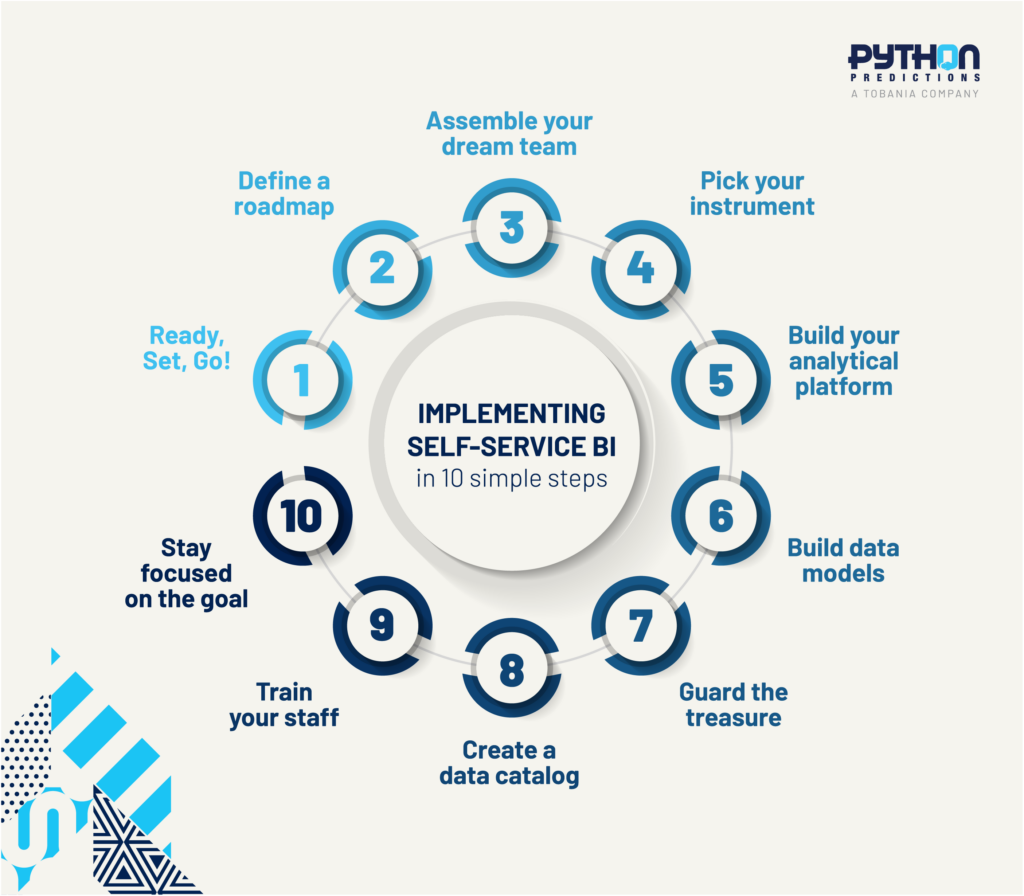When it comes to implementing Business Intelligence (BI), organizations are often plagued by challenges that cut both ways. Business users crave reports and insights on one side and only limited IT reliance on the other. Now … imagine a world in which your employees can quickly access and analyze data themselves, without the need for constant IT support.
“Make IT’s life easier and put the data power in people’s hands“
Welcome to the world of self-service BI! Self-service BI enables your team to make data-driven decisions without having to wait for IT to develop reports to satisfy business users’ desires. Curious? Well, in this article, we will walk you through 10 simple steps to implement self-service BI yourself and unlock the power of data within your organization.

Here are 10 simple steps to give the data power to the people:
1. Ready, Set, Go!
Before you start, assess whether your organization is ready for self-service BI. Make sure your team is eager to embrace a data-driven culture and possesses the right mix of skills to ensure a smooth transition. In practice, doing this will result in conducting a data maturity assessment.
2. Define a roadmap
Define your goals for self-service BI. Make sure you invest the right amount of time in identifying both your current and future needs and challenges. In fact, consider it as if you were setting the destination of your GPS before embarking on a road trip. Therefore, it is important to decide on solving business problems that are going to boost your business strategy.
3. Assemble your dream team
Identify key players – such as business users, IT staff and data consultants – and bring them together in order to establish a team to drive the implementation process.
4. Pick your instrument
Pick the right self-service BI tool to suit your organization’s needs, like you would choose the perfect pair of shoes to match your outfit. Microsoft Power BI and Tableau are among the best tools on the market. Both Tableau and Microsoft offer cloud-based solutions and therefore do not require major IT efforts.
5. Build your analytical platform
Prepare your data, integrate it by cleaning and standardizing it, and finally make it accessible via an analytic data platform. This step involves designing the platform architecture, building the data ingestion and ETL, and configuring data storage solutions.
6. Build data models
Create reusable data models that serve as blueprints for your team to access and understand data quickly. Developing a common data model can serve as a first step. Such a common data model includes the most commonly used metrics and dimensions across your organization.
7. Guard the treasure
Establish a data governance and security policy to ensure an appropriate use of your data assets. The governance strategy should provide a clear set of rules on which user activities are allowed and which are not. Well-defined policies should increase the effectiveness of data within your organization.
8. Create a data catalog
Develop a data catalogue to help all users find and understand data easily. Consider this step similar to a librarian organizing books on the same subject in a library.
9. Train your staff
Teach and support your users in using self-service BI tools and interpreting data, like a coach leads the sports team to victory.
10. Stay focused on the goal
Monitor and maintain your self-service BI environment and adjust it whenever necessary to ensure it continues to meet your organization’s objectives.
In a nutshell
Implementing self-service BI is easier than you might think! By following these 10 simple steps, you will enable your team to unlock the insights hidden in your organization’s data. Remember, the key to success lies in building the right team, fostering a data-driven culture and choosing the right tools. So start your self-service BI journey today and watch your organization flourish thanks to the power of data-driven decision-making.
Want to know more about self-service BI, and how to get started with it? If so, don’t hesitate to take a look at our data team’s approach and practices and get in touch to schedule an initial introductory meeting!



